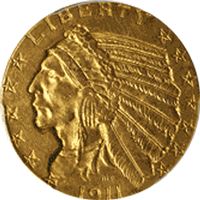$2.5 Indian Gold Coins (Non Certified)
- Gold
- Silver
- Platinum
- Palladium
- 1 gram
- 2.5 gram
- 5 gram
- 10 gram
- 50 gram
- 100 gram
- 250 gram
- 1/20 oz
- 1/10 oz
- 1/5 oz
- 1/4 oz
- 1/2 oz
- 1 oz
- 2 oz
- 5 oz
- 10 oz
- 20 oz
- 50 oz
- 100 oz
- 1/2 kilo
- 1 kilo
- 5 kilo
- 10 kilo
- Gold
- Pre 1933 Gold
- All Pre 1933 US Gold
- $20 St. Gaudens Gold
- $20 St. Gaudens Gold Certified
- $20 Liberty Gold
- $20 Liberty Gold Certified
- $10 Liberty Gold Coins
- $10 Liberty Gold Certified
- $10 Indian Gold Coins
- $10 Indian Head Gold Certified
- $5 Liberty Gold
- $5 Liberty Gold Certified
- $5 Indian Gold Certified
- $2.5 Liberty Gold
- $2.5 Liberty Gold Certified
-
$2.5 Indian Gold
- $2.5 Indian Gold Certified
- Other Pre 1933 US Gold
$2.5 Indian Gold Coins (Non Certified)
Beginning in 1908, the U.S. Mint made a radical departure from all of its previous coin designs. For the first time ever, the mint commissioned a design that used the incuse technique -- something that had never been attempted on an American coin.
This gave birth to the $2.50 Indian Gold Quarter Eagle. The new Indian Head theme was created by the renowned artist Bela Lyon Pratt. The incused image differed from all of its predecessors by sinking the image into the surface of the coin. This is the opposite of "normal" designs where the image is raised above the field of the coin in relief. In the art world, this technique is called incuse.
Sometimes, people don't embrace change. The $2.5 Indian Head quarter eagle design didn't catch on at the time with the general public. There was a misconception that the recessed portions of the incuse engraving style would accumulate dirt and spread disease. Although no such thing happened, Pratt's innovation was rejected by many Americans in the early 20th century.
Today, however, these $2.5 Gold Indian coins are finally receiving their due respect. Their 0.12094 troy ounce of pure gold by weight makes them an excellent choice for investors that want to increase how much gold bullion the hold at an affordable price. Just as importantly, the collectible nature of these coins has increased over time. Because the coin was only minted for a short time, it is a relatively easy series to complete. Production ran from 1908 until 1929, but no quarter eagles were produced between the years 1916 and 1924.
As legal tender, these coins were given the intriguing face value of $2.50. Like previous versions of the denomination, the coins have a diameter of 18 mm and were struck from an alloy of 90% gold and 10% copper.
The obverse design shows an American Indian chief wearing a feathered warbonnet as he faces left. His face bears a stoic expression. Thirteen stars along the outer rim are divided by the legend "LIBERTY" at the top and the year-date at the bottom. The reverse design shows an American bald eagle at rest on a tree branch that an olive branch wraps around like a vine.
With the incuse style, the lettering and other features of the design are recessed beneath the field. The same designs of a Native American and an eagle created by Pratt also appeared on the slightly larger $5 half eagle.




